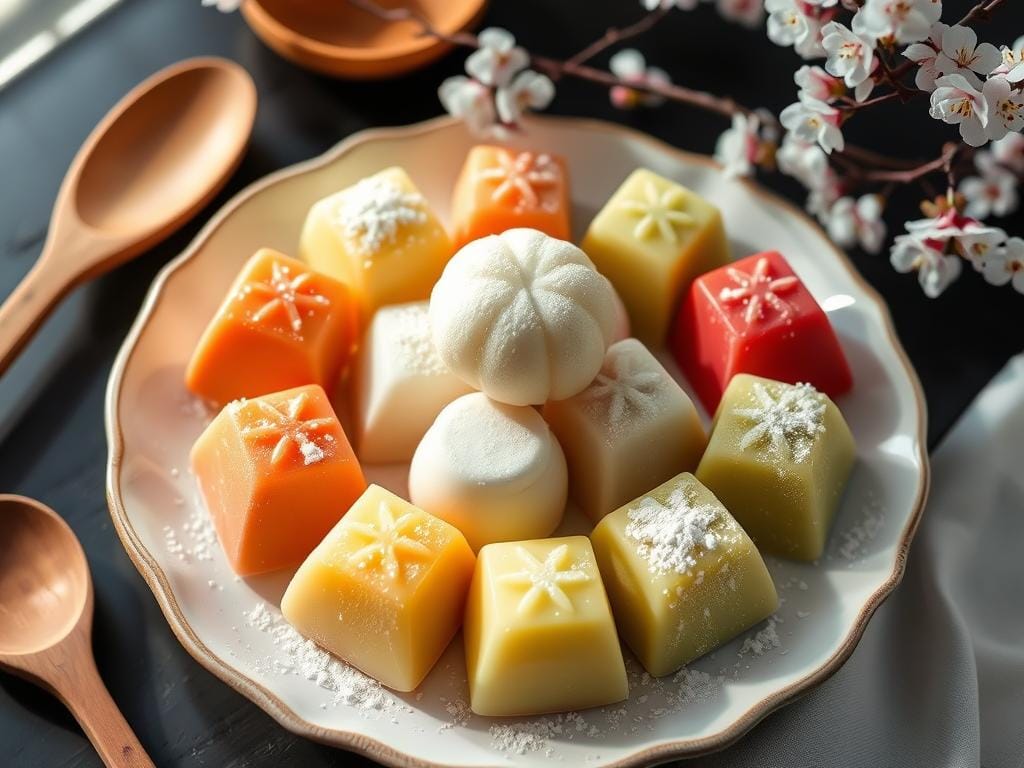My first taste of Japanese mochi was unforgettable. Its soft texture and sweet flavor captivated me. This dessert is more than a treat; it’s a journey through Japanese tradition in your kitchen.
Learn how to make Japanese Rice Cake with Ice Cream
king this mochi recipe is surprisingly simple. With a few ingredients and patience, you can make a chewy delight. This guide is for everyone, whether you’re experienced or new to cooking. It will help you make a sweet treat that’s irresistible.
Key Takeaways
- Mochi is a traditional Japanese dessert with a uniquely soft, chewy texture
- Homemade mochi recipe can be prepared in under 30 minutes
- Basic ingredients include glutinous rice flour, sugar, and water
- You can customize mochi with various flavors and fillings
- Proper techniques ensure the perfect mochi consistency
Understanding Traditional Japanese Mochi
Mochi is more than a tasty dessert in Japanese culture. It’s a tradition that brings people together, celebrates special times, and honors the seasons. Making mochi connects families across generations, showing the value of cultural practices.
The Cultural Significance of Mochi
In Japan, mochi is very important, like during the Lunar New Year. Families come together for mochi pounding, a time to bond. This tradition, called Mochitsuki, turns making rice into a special shared moment.
- Central to Japanese New Year celebrations
- Symbolizes community and familial connections
- Represents seasonal transitions and cultural heritage
Traditional vs Modern Preparation Methods
Making traditional mochi is a detailed process that shows great skill. It starts with soaking sweet glutinous rice overnight, then steaming it. Historically, two people pounded the rice together, one with a mallet and the other shaping it.
Nowadays, making mochi is easier with modern tools like microwaves and food processors. Yet, many Japanese families prefer the old way of pounding mochi.
Why Mochi is a Beloved Dessert
Mochi’s unique texture and ability to take on many flavors make it special. It’s chewy and can be filled with sweet red bean paste or even ice cream. This has made mochi popular around the world.
- Gluten-free alternative to traditional desserts
- Low in fat
- Adaptable to numerous flavor profiles
Essential Ingredients for Perfect Mochi Recipe
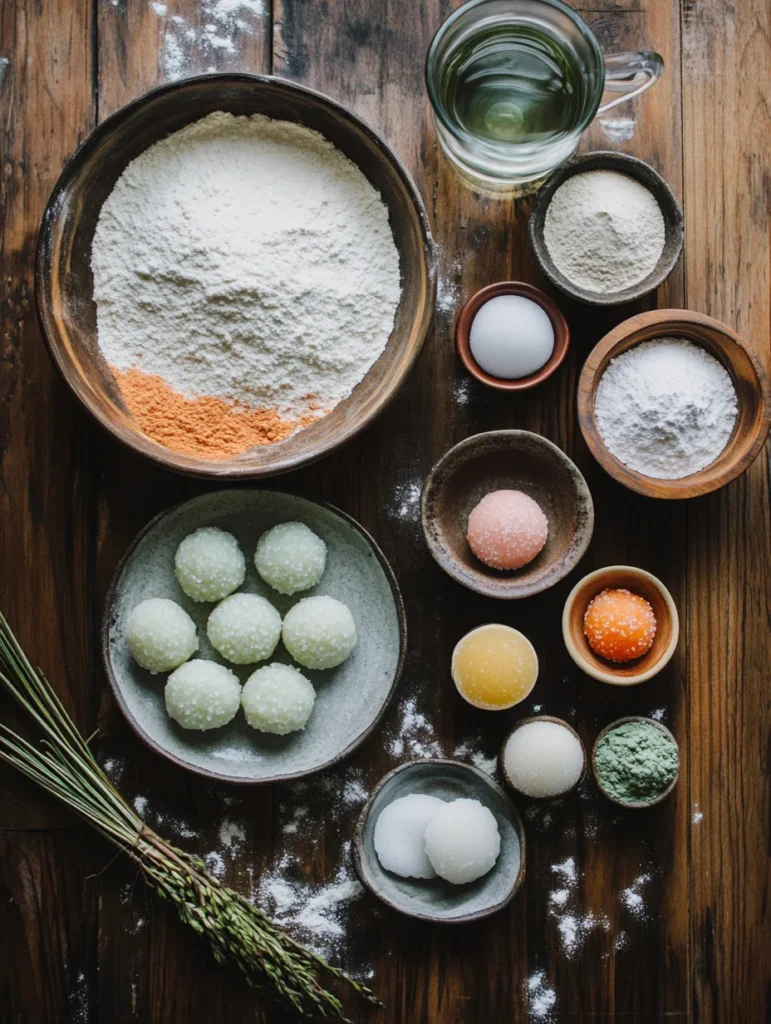
Making delicious homemade mochi begins with the right ingredients. Glutinous rice flour is key for that soft and chewy texture everyone adores.
Here are the main ingredients for authentic mochi:
- Mochiko (sweet glutinous rice flour) – 1½ cups
- Granulated sugar – 1 cup
- Water – 1½ cups
- Cornstarch (for dusting) – as needed
- Optional: 2 drops of vinegar for enhanced texture
For the best mochi, use high-quality mochiko flour. It’s different from regular rice flour and is essential for the right mochi texture.
| Ingredient | Quantity | Purpose |
|---|---|---|
| Mochiko Flour | 1½ cups | Creates chewy base |
| Sugar | 1 cup | Adds sweetness |
| Water | 1½ cups | Binds ingredients |
| Cornstarch | As needed | Prevents sticking |
Pro tip: Always measure your mochi ingredients precisely. The right proportions ensure a perfect texture every time you make this delightful Japanese treat.
Step-by-Step Preparation Method
Making the perfect mochi recipe needs patience and precision. It turns simple ingredients into a delightful Japanese dessert that pleases the senses.
Mixing and Combining Ingredients
Begin by gathering your glutinous rice flour and key ingredients. The secret to a great mochi recipe is precise measurement and mixing.
- Measure glutinous rice flour precisely
- Use room temperature water
- Mix ingredients until smooth
Cooking Techniques: Microwave vs Steaming
You have two main ways to prepare mochi dough:
| Microwave Method | Steaming Method |
|---|---|
| Quick (2 minutes total) | Traditional approach (1 hour) |
| Easy home preparation | Authentic texture |
| Convenient for beginners | Preferred by purists |
Rolling and Shaping Your Mochi
After cooking, your mochi dough needs careful handling. Coat your work surface with potato starch (katakuriko) to prevent sticking. Roll the dough to about ¼-inch thickness.
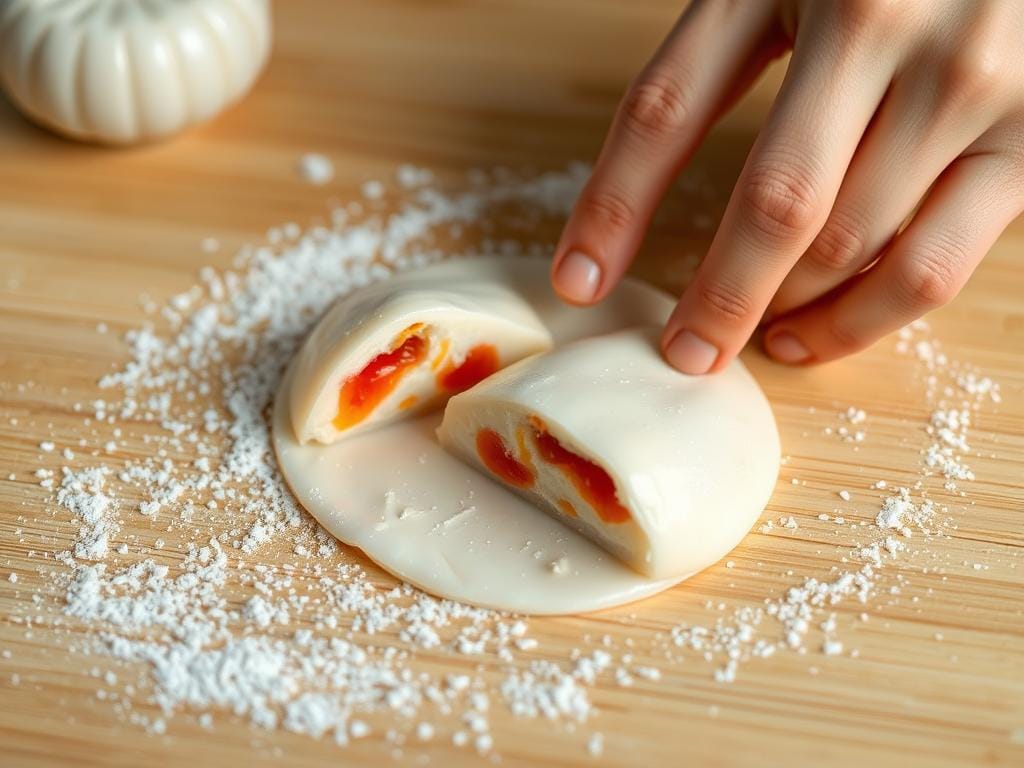
For the best results, chill the dough circles for about 5 minutes before shaping. This helps manage the sticky texture and makes handling easier during your mochi making process.
Creative Mochi Variations and Flavors
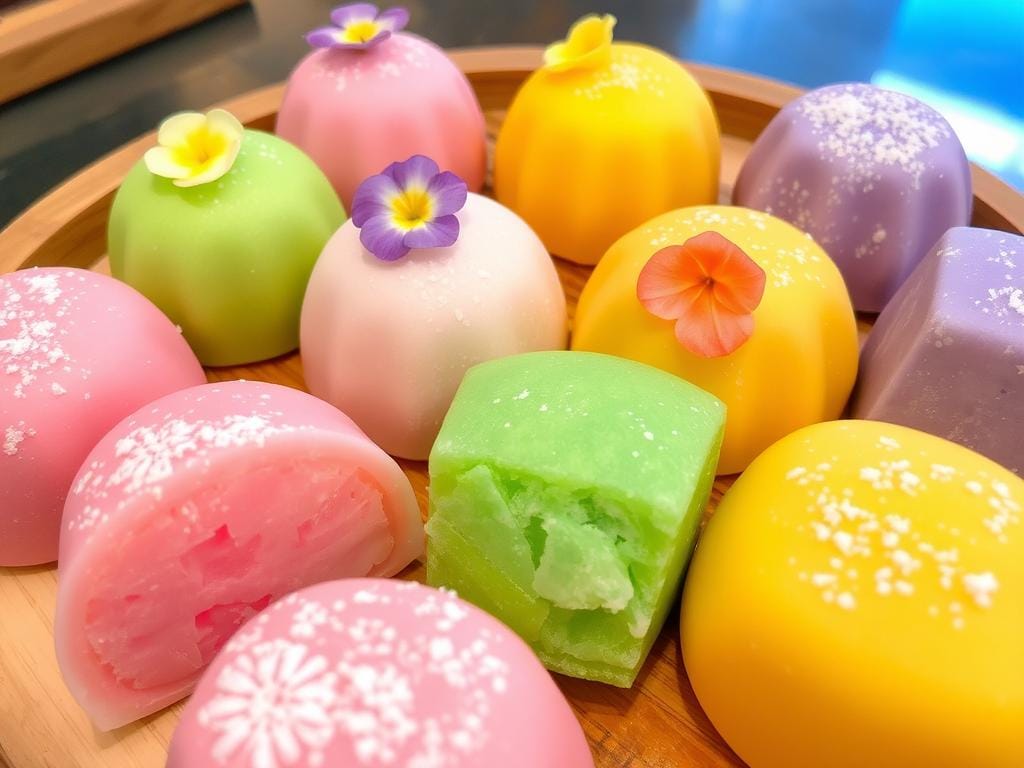
Discover the exciting world of mochi variations. This traditional Japanese treat can become a canvas for creativity. You can try endless flavors and fillings that will make your taste buds happy.
Flavor Exploration
Mochi variations offer a playground of taste sensations. You can try classic and innovative flavors. These bring unique character to your mochi:
- Matcha green tea powder for an earthy, traditional twist
- Cocoa powder for rich chocolate mochi
- Fruit extracts like strawberry or mango for bright, fruity notes
- Turmeric for golden-hued mochi with subtle spice
Exciting Mochi Fillings
The magic of mochi comes alive with its versatile fillings. You can choose from traditional and modern options:
| Traditional Fillings | Modern Fillings |
|---|---|
| Red bean paste | Ice cream |
| White bean paste | Fresh fruit chunks |
| Mung bean paste | Chocolate ganache |
Mochi Toppings and Presentation
Elevate your mochi with creative toppings and decorative techniques. Dust your mochi with sweet potato starch or cornstarch for a delicate finish. Try coating them in crushed nuts, coconut flakes, or a light chocolate drizzle. This adds texture and visual appeal.
Your homemade mochi can become a stunning dessert. It showcases both traditional techniques and your personal culinary creativity.
Tips for Perfect Texture and Storage
Creating the perfect sticky rice dessert is all about the details. Your success with mochi depends on mastering texture and storage.
Achieving the Right Consistency
Getting the right mochi texture is all about the ingredients. Here are some key tips:
- Use a 3:3:1 ratio of mochiko sweet rice flour, water, and sugar
- Add corn syrup for smoothness and pliability
- Dust with potato starch to prevent sticking
- Cook until the mixture turns translucent
Storage Guidelines
Storing your homemade mochi right keeps it fresh and tasty. Here’s how to do it:
| Storage Method | Duration | Recommended Technique |
|---|---|---|
| Room Temperature | 1-2 days | Wrap individually in plastic wrap |
| Refrigerator | 3-4 days | Store in airtight container |
| Freezer | Up to 3 months | Wrap tightly in plastic, then place in freezer bag |
Troubleshooting Common Issues
When making mochi, watch out for these common problems:
- Rubbery texture: Too little sugar is usually the cause
- Sticky consistency: More potato starch can help
- Dry mochi: Cook it less or adjust the liquid ratio
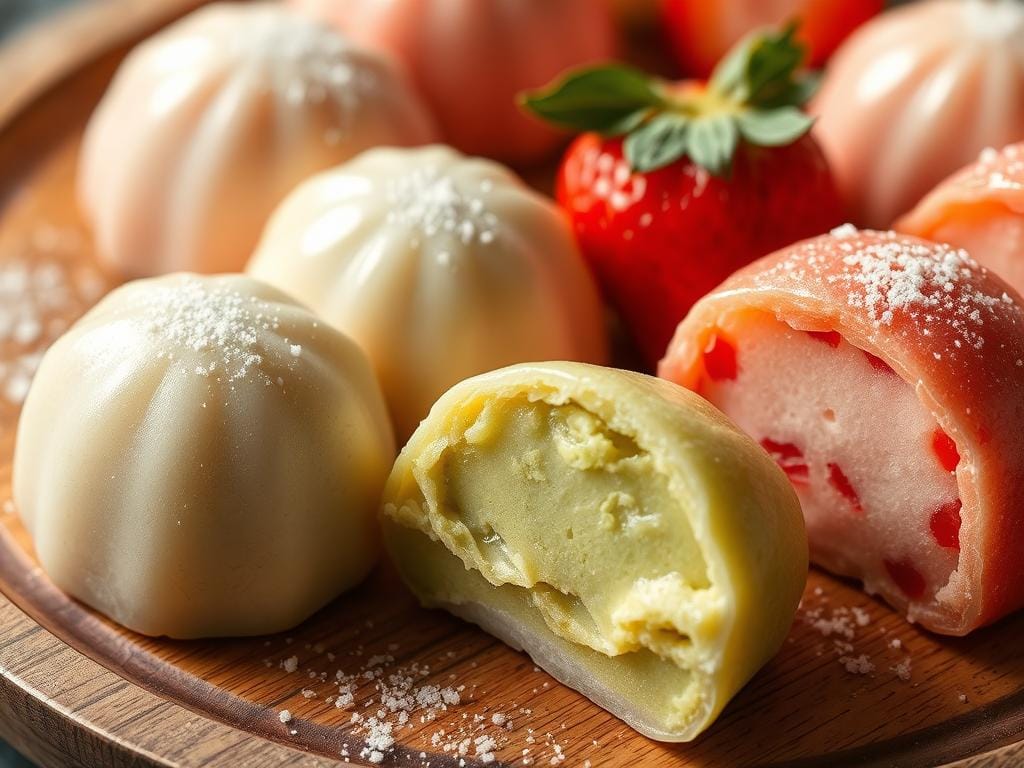
Remember, making mochi is a skill that improves with practice. Each try will make your mochi better and better.
Conclusion
Making homemade mochi is more than a skill—it’s a fun dive into Japanese culture. You’ve learned how to make a chewy treat that brings people together. This guide has shown you how to turn simple ingredients into something special.
Japanese mochi is a canvas for your creativity. You can make it with coconut, chocolate, or other flavors. It’s also gluten-free, making it a treat for everyone, no matter their diet.
Don’t worry if it’s not perfect at first. Every batch you make will help you get better. Whether you stick to traditional recipes or try new ones, enjoy the journey and the tasty outcome.
Learning to make mochi will impress your loved ones and connect you to a global tradition. Begin your mochi-making adventure today. See how much fun you can have making this Japanese delight in your kitchen.
FAQ
Q: What is mochi and where does it originate from?
A: Mochi is a traditional Japanese dessert. It’s made from glutinous rice flour, known for its soft, chewy texture. It has been a staple in Japanese cuisine for centuries, enjoyed during festivals and special occasions like Lunar New Year.
Q: What ingredients do I need to make mochi at home?
A: To make basic mochi, you’ll need glutinous rice flour, water, sugar, and cornstarch or potato starch for dusting. You can also add food coloring, flavoring extracts like matcha or vanilla, and various fillings such as red bean paste or ice cream.
Q: What cooking methods can I use to make mochi?
A: You can make mochi at home using two methods: microwave and steaming. The microwave method is quicker and easier for beginners. The steaming method is more traditional and can give a slightly different texture.
Q: How do I prevent mochi from becoming too sticky when handling?
A: To avoid stickiness, dust your work surface and hands with cornstarch or potato starch. Work quickly and use a light touch when shaping. Keep additional starch nearby to manage the sticky texture.
Q: What are some popular mochi flavors and fillings?
A: Popular mochi flavors include matcha, chocolate, strawberry, and vanilla. Traditional fillings are red bean paste (azuki). Modern variations feature ice cream, fruit purees, and even savory fillings.
Q: How long can I store homemade mochi?
A: Fresh mochi is best eaten within 1-2 days when stored at room temperature in an airtight container. For longer storage, refrigerate mochi for up to a week or freeze it for up to a month. Always wrap individual pieces to prevent sticking and drying out.
Q: Is mochi gluten-free?
A: Traditional mochi made with glutinous rice flour is naturally gluten-free. Always check ingredient labels and be cautious of cross-contamination if you have gluten sensitivities.
Q: Can I make mochi without special equipment?
A: Yes! You don’t need a wooden mallet (Mochitsuki) to make mochi at home. Use a microwave, steamer, or even a rice cooker. Basic kitchen tools like a mixing bowl, spatula, and baking sheet are enough.
Q: Are there any vegan mochi recipes?
A: Most basic mochi recipes are naturally vegan. They use glutinous rice flour, water, and sugar. Choose plant-based fillings like red bean paste or fruit preserves to keep it vegan-friendly.
Q: What is the difference between mochi and regular rice?
A: Mochi is made from glutinous rice, which has a higher starch content than regular rice. This gives mochi its chewy, stretchy texture, making it different from traditional rice preparations.

